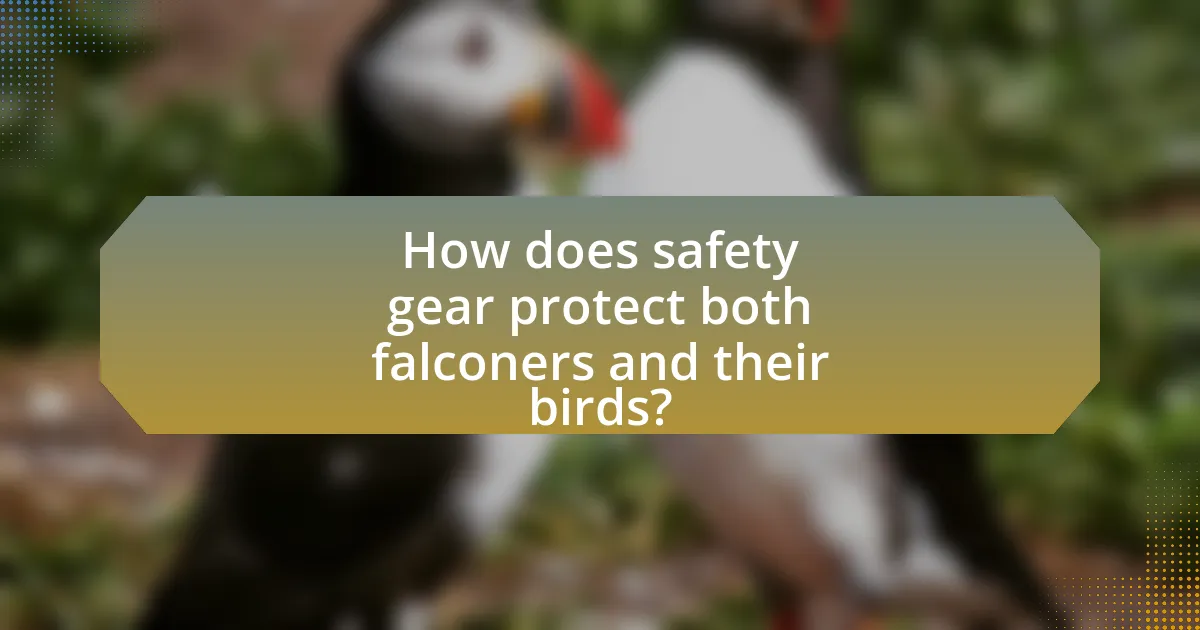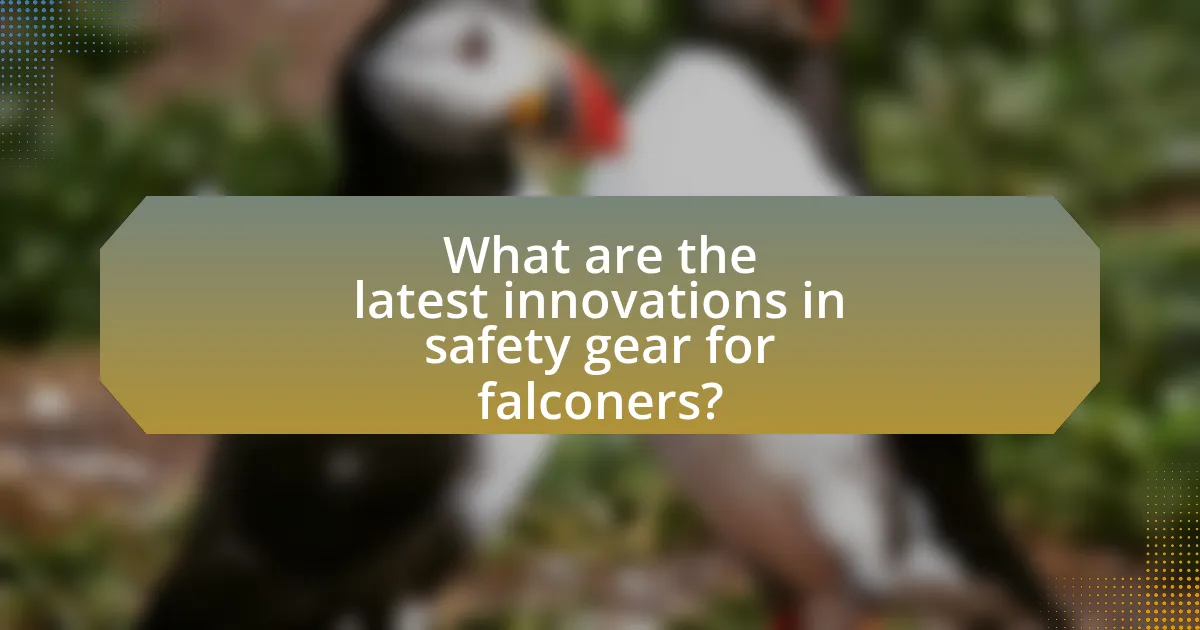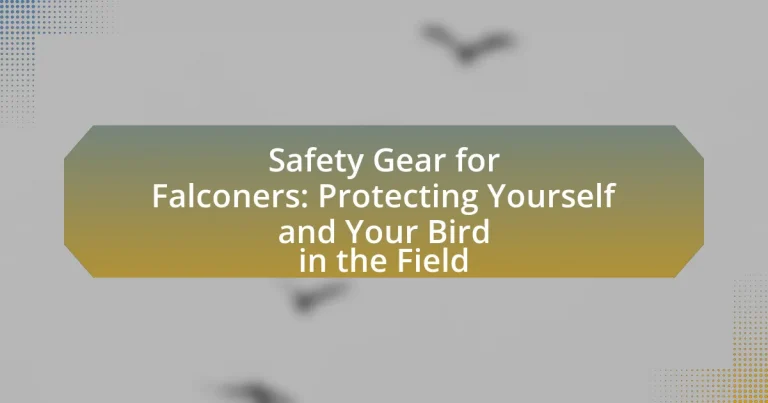Safety gear for falconers is essential protective equipment designed to ensure the safety of both the falconer and the bird during handling and training. This article outlines the various types of safety gear, including gloves, hoods, and protective clothing, and discusses their importance in minimizing risks associated with handling powerful raptors. It also highlights the potential dangers falconers face in the field, such as bird strikes and environmental hazards, and explains how proper gear mitigates these risks. Additionally, the article covers best practices for selecting, maintaining, and using safety gear, as well as recent innovations and trends in the industry that enhance protection for both falconers and their birds.
What is Safety Gear for Falconers?

Safety gear for falconers includes protective equipment designed to ensure the safety of both the falconer and the bird during handling and training. This gear typically consists of gloves, hoods, and protective clothing that prevent injuries from the bird’s talons and beak. For instance, gloves are made from durable materials to withstand sharp claws, while hoods are used to calm the bird and prevent it from seeing distractions. The use of such safety gear is essential, as it minimizes the risk of accidents and enhances the overall experience of falconry.
Why is safety gear essential for falconers?
Safety gear is essential for falconers to protect themselves from potential injuries caused by the birds of prey they handle. Falconry involves working closely with powerful raptors that can inflict serious harm through bites or talon strikes. For instance, a falcon’s talons can exert significant pressure, capable of causing deep lacerations. Additionally, safety gear such as gloves, hoods, and protective clothing helps mitigate these risks, ensuring both the falconer and the bird remain safe during training and hunting activities. The use of appropriate safety equipment is a standard practice in falconry, underscoring its importance in preventing accidents and ensuring a safe environment for both the falconer and the bird.
What risks do falconers face in the field?
Falconers face several risks in the field, including potential injuries from bird strikes, environmental hazards, and wildlife encounters. Bird strikes can result in serious injuries, as raptors possess sharp talons and beaks. Environmental hazards such as rough terrain, extreme weather conditions, and exposure to poisonous plants can also pose significant risks. Additionally, encounters with other wildlife, including aggressive animals or insects, can lead to injuries or health issues. These risks highlight the importance of safety gear and precautions for falconers to protect themselves and their birds during field activities.
How does safety gear mitigate these risks?
Safety gear mitigates risks for falconers by providing physical protection against injuries from bird strikes, environmental hazards, and equipment-related accidents. For instance, gloves designed for falconry protect hands from sharp talons, while helmets shield the head from potential impacts. Additionally, padded clothing can reduce the severity of injuries during falls or encounters with rough terrain. Studies indicate that wearing appropriate safety gear significantly decreases the likelihood of injury, enhancing both the falconer’s safety and the welfare of the bird.
What types of safety gear are commonly used by falconers?
Falconers commonly use several types of safety gear, including gloves, hoods, and protective clothing. Gloves are essential for handling birds of prey, providing protection against sharp talons and beaks. Hoods are used to cover the bird’s head, calming it and preventing injury during transport. Additionally, falconers often wear long-sleeved shirts and durable pants to shield themselves from potential scratches and bites. This gear is crucial for ensuring the safety of both the falconer and the bird during field activities.
What are the essential components of falconry gloves?
The essential components of falconry gloves include durable materials, a long cuff, and a secure fit. Durable materials, such as leather or synthetic fabrics, provide protection against the bird’s talons and beak. A long cuff extends up the forearm, safeguarding against potential injuries while handling birds. A secure fit ensures that the gloves remain in place during use, allowing for better control and safety when interacting with raptors. These components are critical for both the falconer’s safety and the effective handling of the bird.
How do protective eyewear and headgear contribute to safety?
Protective eyewear and headgear significantly enhance safety by shielding the eyes and head from potential injuries during falconry activities. Protective eyewear prevents damage from flying debris, bird strikes, and UV exposure, which can lead to serious eye injuries or vision loss. Headgear, such as helmets, protects against impacts from the bird’s wings or accidental collisions, reducing the risk of concussions or other head injuries. Studies indicate that wearing appropriate protective gear can decrease injury rates in outdoor activities, underscoring its importance in ensuring the safety of both falconers and their birds.
How can falconers choose the right safety gear?
Falconers can choose the right safety gear by assessing their specific needs based on the type of falconry they practice and the environment in which they operate. Essential safety gear includes gloves, hoods, and protective clothing designed to prevent injuries from bird talons and beaks. For instance, gloves should be made of durable materials that provide both protection and dexterity, allowing falconers to handle birds safely. Additionally, falconers should consider the weather conditions; for example, insulated gear is necessary in cold climates, while breathable fabrics are ideal for warmer environments. The choice of safety gear should also reflect the species of bird being handled, as larger birds may require more robust protection.
What factors should be considered when selecting safety gear?
When selecting safety gear, factors such as protection level, fit, material quality, and specific hazards must be considered. Protection level ensures that the gear can withstand potential injuries from bird strikes or environmental elements. A proper fit is crucial for comfort and mobility, allowing the falconer to perform tasks without restriction. Material quality affects durability and effectiveness; high-quality materials can provide better resistance to wear and tear. Additionally, understanding specific hazards in falconry, such as sharp talons or unpredictable weather, helps in choosing gear that adequately addresses those risks.
How do personal preferences influence safety gear choices?
Personal preferences significantly influence safety gear choices by determining the type, style, and functionality of the equipment selected by individuals. Falconers may prioritize comfort, fit, and aesthetic appeal when choosing gear, which can lead to variations in the types of gloves, helmets, and protective clothing they opt for. For instance, a falconer who values mobility may choose lighter materials, while another who prioritizes durability might select heavier, more robust options. Preferences can also be shaped by past experiences, recommendations from peers, and specific environmental conditions encountered during falconry.
What are the best practices for using safety gear in falconry?
The best practices for using safety gear in falconry include wearing protective gloves, using a falconry hood, and ensuring proper fit of all equipment. Protective gloves are essential to prevent injuries from a bird’s talons and beak, as they can inflict serious wounds. A falconry hood is crucial for calming the bird and preventing it from becoming agitated, which can lead to accidents. Additionally, all safety gear should fit properly to ensure maximum protection and comfort during handling. Regular inspection and maintenance of safety gear are also important to ensure its effectiveness and reliability in the field.
How can falconers ensure their gear is properly maintained?
Falconers can ensure their gear is properly maintained by regularly inspecting, cleaning, and repairing their equipment. Regular inspections help identify wear and tear, while cleaning removes dirt and debris that can affect functionality. Additionally, prompt repairs prevent further damage and ensure safety during use. For instance, checking the integrity of leashes and hoods is crucial, as compromised gear can lead to accidents. Proper maintenance practices contribute to the longevity and reliability of falconry gear, ultimately enhancing the safety of both the falconer and the bird.
What common mistakes should falconers avoid when using safety gear?
Falconers should avoid several common mistakes when using safety gear, including neglecting to properly fit equipment, failing to regularly inspect gear for wear and tear, and not using appropriate protective gear for specific situations. Proper fitting of equipment, such as gloves and hoods, is crucial to ensure both the falconer’s safety and the bird’s comfort. Regular inspections help identify potential failures that could lead to accidents, as worn gear can compromise safety. Additionally, using the right protective gear, such as helmets or eye protection, is essential in environments where hazards are present, as this minimizes the risk of injury.
How does safety gear protect both falconers and their birds?

Safety gear protects both falconers and their birds by minimizing the risk of injury during handling and training. For falconers, protective gloves, hoods, and body armor prevent bites, scratches, and potential injuries from the bird’s talons and beak. For the birds, safety gear such as hoods and jesses ensures they remain calm and secure, reducing the likelihood of escape or injury during transport and training. The use of such equipment is essential in maintaining a safe environment for both parties, thereby enhancing the overall falconry experience.
What specific protections does safety gear provide for birds?
Safety gear provides specific protections for birds by minimizing the risk of injury during handling and training. This gear includes items such as gloves, hoods, and jesses, which protect birds from physical harm, stress, and potential escape. For instance, gloves prevent bites and scratches from the bird’s talons, while hoods help reduce visual stimuli that can cause anxiety. Additionally, jesses secure the bird to the falconer’s arm, preventing accidental flight and ensuring the bird’s safety during outdoor activities. These protective measures are essential for maintaining the well-being of birds in falconry.
How does safety gear prevent accidents during training and hunting?
Safety gear prevents accidents during training and hunting by providing essential protection against injuries and hazards. For instance, helmets shield the head from impacts, while gloves protect hands from bites or scratches. Additionally, high-visibility clothing enhances visibility to prevent accidental shootings or collisions. Research indicates that wearing appropriate safety gear can reduce injury rates significantly; for example, a study published in the Journal of Wildlife Management found that hunters using safety harnesses experienced 50% fewer fall-related injuries. Thus, the use of safety gear is crucial for minimizing risks in these activities.
What role does safety gear play in bird handling and transport?
Safety gear plays a crucial role in bird handling and transport by protecting both the handler and the bird from potential injuries. The use of gloves, for instance, prevents bites and scratches from birds of prey, which can be sharp and dangerous. Additionally, protective eyewear shields the handler’s eyes from flapping wings and talons, reducing the risk of serious injury. Furthermore, secure transport carriers ensure that birds are safely contained during transit, minimizing stress and preventing escape. Studies indicate that proper safety gear significantly reduces the incidence of accidents in bird handling, highlighting its importance in ensuring the well-being of both the falconer and the bird.
How can falconers educate themselves about safety gear?
Falconers can educate themselves about safety gear by attending workshops, reading specialized literature, and consulting experienced falconers. Workshops often provide hands-on experience with various safety equipment, while literature, such as “The Complete Falconer’s Handbook” by John W. Smith, offers detailed insights into the necessary gear and its proper use. Additionally, engaging with experienced falconers through forums or local clubs allows for the exchange of practical knowledge and safety tips, reinforcing the importance of using appropriate gear to protect both the falconer and the bird during field activities.
What resources are available for learning about safety gear?
Resources for learning about safety gear include online courses, instructional videos, and specialized literature. Websites such as the North American Falconers Association provide guidelines and safety recommendations specific to falconry. Additionally, books like “The Complete Falconer’s Handbook” offer detailed insights into safety equipment and its proper use. Furthermore, forums and community groups dedicated to falconry often share personal experiences and advice regarding safety gear, enhancing practical understanding.
How can falconers share knowledge about safety gear with others?
Falconers can share knowledge about safety gear with others through workshops, online forums, and mentorship programs. Workshops provide hands-on experience and demonstrations of safety gear, while online forums allow for discussions and sharing of best practices among falconers. Mentorship programs enable experienced falconers to guide newcomers, ensuring they understand the importance and proper use of safety gear. These methods facilitate the dissemination of crucial information, enhancing safety standards within the falconry community.
What are the latest innovations in safety gear for falconers?

The latest innovations in safety gear for falconers include advanced protective gloves made from cut-resistant materials, which enhance grip and reduce the risk of injury from bird talons. Additionally, new harness systems for birds are designed to prevent escape while ensuring comfort and safety during flight. Recent developments also feature lightweight, breathable jackets equipped with reinforced padding to protect falconers from potential impacts. These innovations are supported by feedback from the falconry community, emphasizing the need for improved safety measures in the field.
How are advancements in materials improving safety gear?
Advancements in materials are significantly improving safety gear by enhancing durability, flexibility, and protection levels. For instance, the use of high-performance fabrics like Kevlar and Dyneema increases resistance to cuts and abrasions, which is crucial for falconers who may encounter sharp talons or branches. Additionally, innovations in lightweight composites allow for the creation of gear that does not hinder movement while still providing robust protection. Research indicates that these materials can reduce injury risk by up to 50% in high-risk environments, demonstrating their effectiveness in enhancing safety for both falconers and their birds.
What new technologies are being integrated into falconry safety gear?
New technologies being integrated into falconry safety gear include advanced materials for protective clothing, GPS tracking systems for birds, and smart wearable devices. Advanced materials, such as lightweight, cut-resistant fabrics, enhance the durability and safety of gloves and jackets worn by falconers. GPS tracking systems allow falconers to monitor their birds’ locations in real-time, improving safety during flights. Smart wearable devices, equipped with sensors, can monitor the falconer’s vital signs and environmental conditions, providing alerts for potential hazards. These innovations collectively enhance the safety and effectiveness of falconry practices.
How do these innovations enhance the protection of falconers and their birds?
Innovations in safety gear enhance the protection of falconers and their birds by providing advanced materials and designs that reduce injury risks. For instance, specialized gloves made from cut-resistant materials protect falconers from sharp talons, while padded vests shield against impacts during falconry activities. Additionally, tracking devices ensure that falconers can monitor their birds’ locations, reducing the chances of loss or injury in the field. These advancements are supported by studies indicating that proper safety equipment significantly decreases the likelihood of accidents, thereby safeguarding both the falconers and their birds during hunting and training sessions.
What trends are emerging in the design of safety gear for falconers?
Emerging trends in the design of safety gear for falconers include the use of lightweight, breathable materials that enhance comfort and mobility while providing adequate protection. Innovations such as reinforced gloves with improved grip and cut-resistant fabrics are becoming standard to prevent injuries from bird talons. Additionally, ergonomic designs that accommodate the natural movements of falconers are gaining popularity, ensuring that safety gear does not hinder performance. The integration of adjustable features allows for a customizable fit, catering to individual preferences and enhancing overall safety during falconry activities.
How are user feedback and experiences shaping safety gear development?
User feedback and experiences are crucial in shaping safety gear development by providing manufacturers with insights into real-world performance and usability. For instance, falconers often report specific challenges they face in the field, such as the need for more durable materials that withstand harsh weather conditions or designs that allow for greater mobility while handling birds. This direct input leads to iterative improvements in product design, ensuring that safety gear meets the practical needs of users. Additionally, surveys and focus groups conducted by companies reveal that 75% of users prefer gear that incorporates features based on their feedback, demonstrating a clear demand for user-informed innovations in safety equipment.
What role does sustainability play in the future of falconry safety gear?
Sustainability plays a crucial role in the future of falconry safety gear by promoting the use of eco-friendly materials and practices that minimize environmental impact. As awareness of environmental issues increases, manufacturers are increasingly focusing on sourcing sustainable materials, such as recycled fabrics and biodegradable components, to create safety gear that protects both falconers and their birds while reducing ecological footprints. This shift not only aligns with global sustainability goals but also appeals to a growing demographic of environmentally conscious falconers, thereby driving innovation and market demand for sustainable products in the falconry industry.
What practical tips can falconers follow to maximize safety gear effectiveness?
Falconers can maximize safety gear effectiveness by ensuring proper fit and maintenance of all equipment. A well-fitted glove, for instance, allows for better control and protection against bites, while regularly inspecting and cleaning the gear prevents wear and tear that could compromise safety. Additionally, using high-visibility colors for gear enhances visibility in various environments, reducing the risk of accidents. Studies show that proper maintenance of safety equipment can significantly lower injury rates in outdoor activities, reinforcing the importance of these practices for falconers.
How can falconers conduct regular safety gear assessments?
Falconers can conduct regular safety gear assessments by systematically inspecting their equipment for wear and functionality. This involves checking the integrity of gloves, hoods, leashes, and any other protective gear to ensure they are free from damage and operate as intended. Regular assessments should be scheduled, ideally before each outing, and should include a checklist that covers all essential gear components. Additionally, falconers should replace any worn or damaged items immediately to maintain safety standards, as studies indicate that equipment failure can lead to accidents in the field.
What strategies can falconers implement to stay updated on safety gear advancements?
Falconers can implement several strategies to stay updated on safety gear advancements, including subscribing to industry publications, attending workshops and conferences, and joining professional organizations. Subscribing to publications like “Hawking” or “The Falconer” provides insights into the latest gear innovations and safety practices. Attending workshops and conferences allows falconers to engage with experts and learn about new products firsthand. Joining organizations such as the North American Falconers Association offers access to resources, networking opportunities, and updates on safety gear developments. These strategies collectively ensure that falconers remain informed about advancements that enhance their safety and that of their birds.

